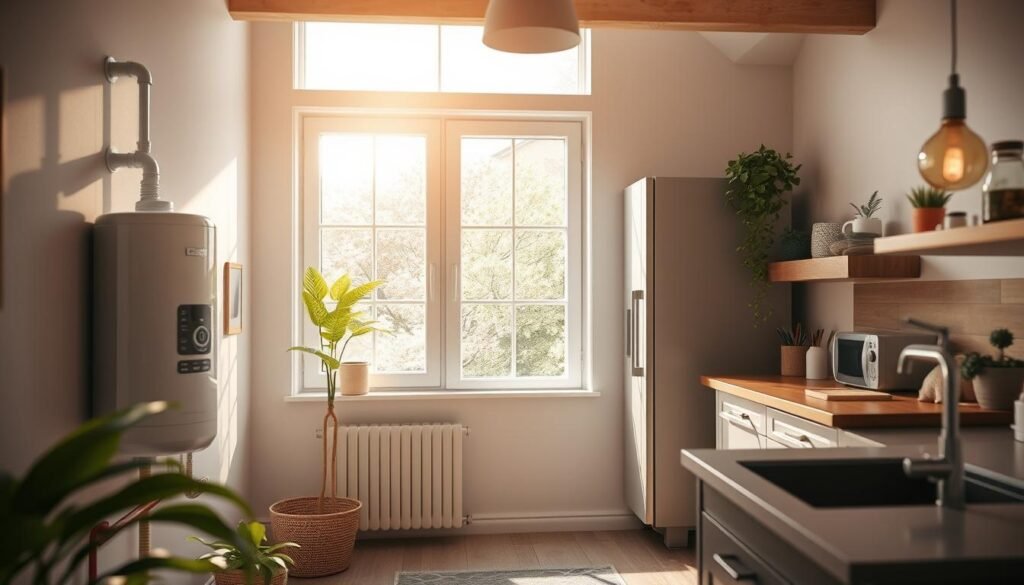As a homeowner, I’ve always looked for ways to cut down on energy use and lower my bills. It’s not just about saving money. It’s about helping our planet for future generations. In this guide, I’ll share tips that have made my home more efficient and cost-effective.
Key Takeaways
- Understand the basics of home energy consumption and identify common sources of waste
- Discover the benefits of smart thermostat solutions for better temperature control and efficiency
- Learn effective weatherproofing techniques to seal air leaks and improve insulation
- Adopt energy-saving strategies for daily household activities, such as laundry and cooking
- Explore lighting upgrades, including LED bulbs and natural light optimization, to cut electricity costs
Understanding Home Energy Consumption Basics
Learning about home energy use is key to saving energy. By looking at how you use energy and your bills, you can spot ways to save. This helps you make smart choices to use less energy.
Common Sources of Energy Waste
Many people don’t know what wastes energy at home. Things like old appliances, leaky windows, and outdated heating and cooling systems use more energy. Fixing these can really cut down your energy bills.
How to Read Your Energy Bill
Reading your energy bill can teach you a lot. Look for your total energy use, cost per kilowatt-hour, and any special charges. This info helps you find ways to use less energy and save money.
Peak vs. Off-Peak Usage Times
Knowing when to use energy is important. Peak times are usually when everyone is home and using lots of energy. Off-peak times are when it’s quieter, like at night or weekends. Using energy when it’s cheaper can save you a lot.
| Peak Usage Times | Off-Peak Usage Times |
|---|---|
| Monday – Friday, 7 AM – 9 PM | Monday – Friday, 9 PM – 7 AM, Weekends, and Holidays |
By understanding home energy basics, you can start saving energy. This leads to lower energy costs for you.
Smart Thermostat Solutions for Better Efficiency
Smart home technology offers a great way to cut down on energy use and improve HVAC efficiency. Programmable thermostats are key. They adjust temperatures automatically and give insights to save energy.
Top smart thermostats like Nest and Ecobee learn your heating and cooling habits. They adjust the HVAC system to save energy and lower bills.
Homeowners can set up custom schedules with smart thermostats. For example, they can make the temperature a bit higher when no one’s home. Then, it adjusts to a cozy level when you return. This smart approach saves a lot of energy without losing comfort.
| Feature | Nest | Ecobee |
|---|---|---|
| Geofencing | ✓ | ✓ |
| Remote Access | ✓ | ✓ |
| Learning Capabilities | ✓ | ✓ |
| Energy Monitoring | ✓ | ✓ |
| Voice Control | ✓ | ✓ |
Upgrading to a smart thermostat can greatly reduce HVAC energy use. This leads to a more sustainable and cost-effective home. Smart home technology gives homeowners better control and efficiency in their heating and cooling.
Weatherproofing Your Home for Maximum Savings
Weatherproofing your home is key to saving energy. Fixing air leaks and adding energy-efficient insulation helps a lot. This reduces heat loss and gain, cutting down your energy use and bills. Let’s look at some ways to make your home more energy-efficient.
Sealing Air Leaks and Drafts
Air leaks and drafts waste a lot of energy. They let warm air out in winter and cool air out in summer. This makes your HVAC work harder and increases your energy bills. To find and fix these leaks, do a home energy audit or use an air leak detection tool. Then, seal them with caulk, weatherstripping, or other sealants to make your home tighter and more energy-efficient.
Proper Insulation Techniques
Good insulation is vital for a weatherproof home. It keeps heat in winter and cool air in summer, easing your HVAC’s workload. When picking energy-efficient insulation, think about R-value, material, and how it’s installed. A pro can help find the best insulation for your home and climate.
Window and Door Maintenance
Windows and doors can be big weatherproofing problems if not kept up. Check them for cracks, gaps, or worn seals and fix them fast. If they’re old or not efficient, think about getting new ones. This can really help your home save energy and money.
Using these weatherproofing tips can make your home much more energy-efficient. This means big savings on your utility bills. Investing in home weatherization is a smart move for a more comfortable and sustainable home.

Energy Saving Tips for Daily Household Activities
Changing your daily habits to save energy can really help. Here are some easy tips to make your daily routine more energy-friendly:
Cooking and Meal Preparation
- Use the microwave or toaster oven for smaller meals instead of the full-sized oven.
- Cover pots and pans while cooking to retain heat and reduce cooking time.
- Utilize the dishwasher’s energy-saving cycle and avoid pre-rinsing dishes.
Laundry Tasks
- Wash full loads of laundry in cold water to minimize energy consumption.
- Clean the lint trap in your dryer after each use to improve efficiency.
- Air-dry clothing whenever possible to reduce reliance on the energy-intensive dryer.
Entertainment and Electronics
- Turn off electronics and appliances when not in use to avoid phantom power draw.
- Unplug chargers and adapters when not in use to eliminate standby power consumption.
- Consider using power strips to easily switch off multiple devices at once.
| Energy-Efficient Habit | Estimated Energy Savings |
|---|---|
| Using the microwave instead of the oven | Up to 50% energy savings |
| Washing clothes in cold water | 25-50% energy savings |
| Unplugging unused electronics | Up to 10% energy savings |
By making these small changes, you can save a lot of energy. This helps your household use less energy and is good for the planet.

“Small changes in our daily routines can have a big impact on reducing our energy footprint.”
Lighting Upgrades That Cut Electricity Costs
Lighting is a big part of what uses energy in homes. By choosing energy-saving lighting, people can cut their electricity bills. They also get brighter, greener light.
LED vs. Traditional Bulbs
Switching to LED bulbs is a smart move to save on lighting costs. LEDs use 80% less energy than old bulbs. They last longer too, saving money over time.
Natural Light Optimization
Using more natural light is another way to save. Open windows, add skylights, and use light colors on walls and ceilings. This lets in more sunlight, cutting down on the need for artificial light.
Smart Lighting Controls
Smart light systems offer a high-tech way to save energy. They let you control lights from anywhere, so you only use them when needed. This can lead to big savings on your electricity bill.

By using energy-saving lights, natural light, and smart controls, homes can save a lot on electricity. These changes make homes more comfortable and help the planet too.
Efficient Appliance Usage and Maintenance
Using your home appliances wisely is key to saving on electricity bills and helping the planet. Understanding energy star appliances, appliance efficiency ratings, and proper appliance maintenance helps you make smart choices. This ensures your appliances work their best.
When buying new appliances, check for the Energy Star label. It shows the product meets high energy efficiency standards from the U.S. Environmental Protection Agency. These efficient models cut down on your bills and help the environment.
Regular upkeep is also vital for your appliances’ efficiency. Simple actions like cleaning fridge coils, changing air filters, and adjusting oven settings can greatly reduce energy use and extend appliance life.
| Appliance | Maintenance Tips | Estimated Energy Savings |
|---|---|---|
| Refrigerator | Clean coils, check seals, adjust temperature | Up to 25% |
| Dishwasher | Clean filters, use eco-friendly detergent, avoid overloading | Up to 20% |
| Washing Machine | Clean lint trap, use cold water, avoid overloading | Up to 30% |
By following these energy-saving tips, you can make your appliances more efficient. This not only cuts down on your energy costs but also helps the environment.

“Proper maintenance and efficient usage of home appliances can lead to significant energy savings and a lower environmental footprint.”
Water Heating Solutions and Conservation
Efficient water heating is key to saving energy at home. Smart strategies can cut down energy use for hot water. Let’s look at some effective ways to save energy with water heating.
Insulating Water Heaters
Insulating your water heater is a smart move. A water heater insulation blanket keeps heat in, saving energy. It’s a simple, affordable way to cut down on your energy bills.
Temperature Optimization
Changing your water heater’s temperature can save energy. Try setting it to 120°F (49°C) or lower. This not only saves energy but also prevents scalding.
Regular checks on your water heater keep it running well. This ensures it uses energy efficiently.
Water-Saving Fixtures
- Low-flow showerheads and faucets save water without losing performance.
- High-efficiency toilets use less water per flush than old models.
- Fixing leaks is crucial to avoid wasting water and energy.
| Water Heating Solution | Benefits |
|---|---|
| Water Heater Insulation | Retains heat, reduces energy consumption |
| Temperature Optimization | Lowers energy costs, improves safety |
| Low-flow Fixtures | Conserve water, decrease water heating needs |
Using these water heating solutions and conservation tips can make your home more efficient. You’ll save on energy bills and help the planet.

Renewable Energy Options for Homeowners
Homeowners are now looking for ways to save energy and help the planet. They’re turning to solar panels, wind energy, and geothermal heating to power their homes. These options can also lower their utility bills.
Solar Panels: Solar panels use sunlight to make electricity for your home. They can go on your roof or in a special area outside. Many people find the savings over time make up for the cost of installing them. Solar panels work best in sunny places.
Wind Energy: Wind turbines are another choice for homeowners, especially where the wind is steady. These turbines can be set up on your land to make electricity. While they cost more upfront than solar, they offer long-term savings.
Geothermal Heating: Geothermal systems use the earth’s heat to keep your home warm or cool. They’re efficient and good for the environment. This technology is a smart choice for those who want to cut down on traditional heating and cooling costs.
When looking at home renewable energy systems, think about your home’s needs and local incentives. Investing in renewable energy can lower your carbon footprint and increase your home’s value. It also saves money in the long run.
| Renewable Energy Option | Advantages | Considerations |
|---|---|---|
| Solar Panels | Generates clean, renewable electricity Potential long-term energy savings Increases home value | Upfront installation costs Dependent on sunlight availability Maintenance requirements |
| Wind Energy | Reliable, consistent power generation Reduces reliance on traditional energy sources Potential long-term energy savings | Upfront installation costs Dependent on wind patterns Potential noise and visual impact |
| Geothermal Heating | Highly energy-efficient heating and cooling Reduces reliance on traditional HVAC systems Long-term energy savings | Significant upfront installation costs Dependent on stable underground temperatures Requires specialized equipment and expertise |
Exploring renewable energy options is a big step towards a greener, more affordable energy future for your home.

“Renewable energy is a critical component of a sustainable future, and homeowners have an opportunity to lead the way in adopting these innovative technologies.”
Seasonal Energy-Saving Strategies
As the seasons change, so should your energy-saving efforts. Adapting your home’s maintenance and usage to the season can save you money. These strategies will help you stay comfortable while cutting down on utility bills.
Summer Cooling Tips
In the summer, try to use less air conditioning. Make sure your HVAC system is well-maintained with regular tune-ups. This boosts its seasonal energy efficiency and makes it last longer. Also, think about getting a smart thermostat to adjust temperatures for you.
Smart landscaping can also cool your home. Planting shade trees or installing awnings can block sunlight. Using light-colored roofing materials can also deflect heat. These landscaping tips can cut down on air conditioning use.
Winter Heating Efficiency
In the cold months, keeping your HVAC in top shape is key. Get your furnace checked every year and change air filters often. Sealing air leaks and adding insulation can also help keep the heat in.
Consider getting a smart thermostat. It can adjust the temperature when you’re not home, saving you energy.
Spring and Fall Maintenance
Spring and fall are great times for home maintenance. Clean your HVAC, clear gutters, and check for repairs or weatherproofing. These steps prepare your home for the next seasons.
Adjusting your energy-saving plans with the seasons can save you money all year. With some upkeep and smart upgrades, your home will be cozy and energy-efficient all year.
Conclusion
In this guide, we’ve covered many ways to save energy and live sustainably. We’ve talked about how to understand your home’s energy use and use smart thermostats. We’ve also discussed weatherproofing and using appliances wisely.
Living energy-efficiently helps the planet and saves you money on bills. These changes can add up to big savings. You can use this money for other things or make your home even more energy-smart.
Remember, every small step counts. Choose the changes that fit your home and your lifestyle best. Enjoy the journey of making your home more sustainable. You’ll be proud of the difference you’re making for the planet and your wallet.


Hello, I’m Jane, founder of Home Vibe Ideas. I’m here to inspire stylish Home Design, modern Smart Living, beautiful Outdoor Spaces, and creative DIY Projects to help you create a home that’s uniquely yours.
Disclosure: This post contains affiliate links. If you click on a link and make a purchase, we may earn a small commission at no additional cost to you. The content on this site was created with the help of AI technology.


